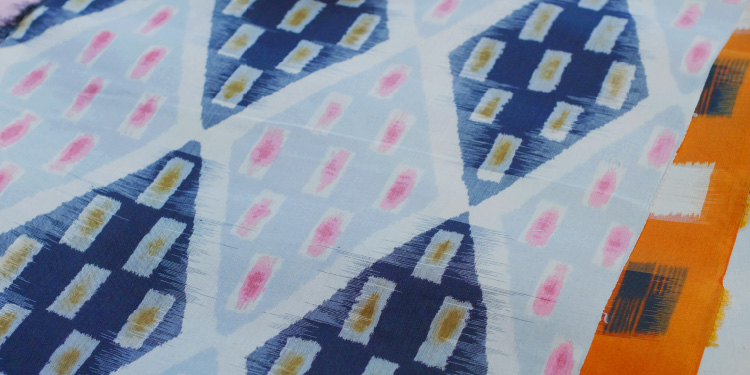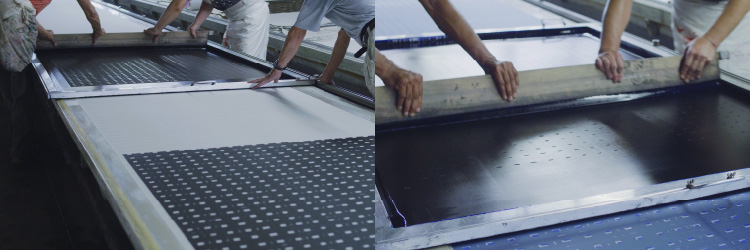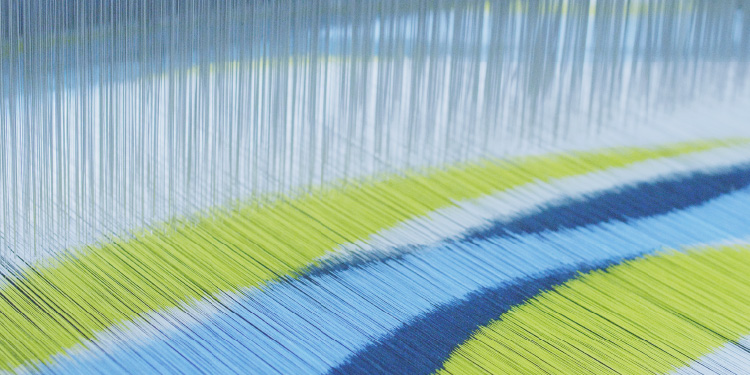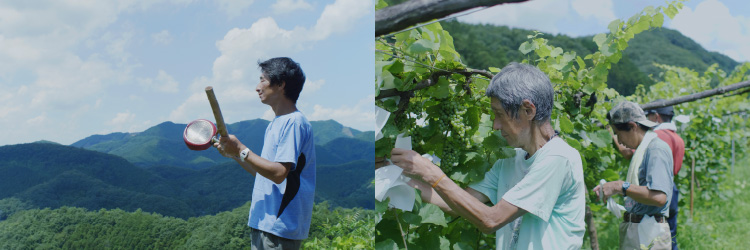

Every morning, I gaze out at the trees from my window. After a while, this fills my heart with a sense of calm. The treetops sway in the wind while countless numbers of leaves flutter. Their serene movement in all different directions is followed by a return to stillness. Why does this simple repetition have such a soothing effect?
A mere photograph does not have this power. The loud commotion of a rainstorm conversely would create feelings of unease. There must be some secret to the gentle swaying motion. Even though each leaf is moving in a different way, the leaves as a whole create one harmonious movement.
In physics, this is called 1/f fluctuations. The natural world is full of these fluctuations—the twinkling of stars, the sound of waves crashing and receding, insect songs in the fall, the pitter-patter of raindrops, the murmuring of a stream. The power of these fluctuations to soothe people is also explained by brain science. The other day I watched a late-night TV program that consisted simply of a bonfire burning. The flickering flames and the crackling wood put me in a pleasantly meditative state. In our busy lives, these kinds of scenes have been forgotten.


In textiles as well, there are also scenes of fluctuation that have been lost. One is the woven fabric called kasuri (also known as ikat). Most people today do not own clothing with kasuri patterns. Almost none are made either. But there was a time when kasuri enchanted people around the world.
The kasuri technique involves dyeing the threads first and then weaving the pre-dyed threads into a pattern, which gives the pattern a blurred or feathered effect at the edges. The simplicity and warmth of the patterns this technique creates have broad appeal. The technique was known as chiné à la branche in France, with even the likes of Marie Antoinette counted among its fans. However, its use rapidly declined and all but disappeared following the industrial revolution of the 19th century. In Japan too, kasuri using juji cross shapes and geometric igeta patterns had been a part of aizome (Japanese indigo dyeing) since ancient times. Still, the technique of binding and dyeing threads, and then unbinding and weaving them together, is labor and time intensive, and most Japanese textiles used simple patterns.


After the Meiji Restoration (1868), engineers from Japan went to Europe to study European dyeing and weaving techniques, and the chiné technique that had been falling into disuse at the time was passed on to them. They then added their own innovations to create a silk textile that became known as meisen. Meisen textiles have the blurred look of kasuri, but instead of traditional patterns they feature graphic designs in vibrant colors. Meisen soared in popularity from the Taisho (1912–1926) to the early Showa (1926–1989) periods. Due to the rise of Western fashions and decline of kimono culture after World War II, however, few people today are familiar with meisen. Fewer people still are proficient in meisen techniques.
Let’s take a closer look at meisen textiles. From a distance the fabric looks as if it has one pattern, but the edges of the design have kasuri’s distinctive blurring. The strands of dyed and woven thread do not match up exactly, creating random fluctuations. The effect is reminiscent of a distant landscape shrouded in spring haze. Like the treetops swaying in the wind, each of the strands of thread seems to whisper in a soft voice.


When we traveled to Ashikaga City to visit this center of meisen, we had another memorable discovery. It was Coco Farm & Winery, built on a steep mountainside that had been cleared and cultivated to provide work for students from Cocoromi Gakuen, an institute for students with intellectual disabilities created by a teacher named Noboru Kawata some decades ago. The white buildings of the winery are nestled in a deep valley. Looking out at the rows of grapevines from a seat on the terrace, you almost feel as if you are traveling in some faraway foreign land.
The students carefully hang paper around individual bunches of grapes to shield them from rain. Lots of weeds grow close to the ground, and grasshoppers and other insects jump around as you walk. Dragonflies and small birds fly about, attracted to this prey. Undergrowth is cut back when it gets too tall, but the land is left in its natural state as much as possible. If herbicides are used to kill the weeds, the insects would also be killed off, and conversely this would leave the grapes exposed to pests that would just want to eat them. Getting rid to those insects would then require spraying even greater amounts of pesticides. But left to nature, a balance is maintained in the food chain. The large numbers of bugs and weeds living in the fields all play a role in this.


We heard the clang of metal from the top of the mountain. Going to investigate, we found someone beating a frying pan. This young man with autism guards the fields from morning to evening, keeping the crows away. Having a job to do every day has given him a greater sense of purpose than when he first entered Cocoromi Gakuen. Everyone has a role to perform, and with it the satisfaction of being of useful.
During harvest time, the students remove damaged grapes one at a time by hand. This handiwork could not be done at wineries where efficiency is the focus. Most companies also use a single strain of artificially cultured yeast for the yeast they use in fermentation. Coco Farm and Winery, however, makes wine using the wild yeast present on the skins of grapes. This yeast is present on the grapes precisely because the winery uses almost no pesticides. Various other microorganisms are also found together with wild yeast, however, making the fermentation process prone to fluctuations and difficult to control. That said, wild fermentation is essential to the wines’ distinctive flavor.
Mr. Ikegami, grandson of the founder, says that wild yeast and the students resemble each other. “Wild yeast is a mix of lots of different qualities, and each one of our diverse group of students shares something in common.”
We were able to sample some of the wine produced here. Coco Farm and Winery currently enjoys an international following, and has always made wine using wild fermentation, long before the current trend of “natural wine.” Its clean, smooth flavor has been fermented with affirmation for all life, from the creatures in the fields to the students working there.
In the modern era, “fluctuations” have been removed in the name of rationalization, but we are now beginning to again recognize the power of fluctuations and the role they play. The rhythm of meisen kasuri threads, and the wine born from life’s diversity, are both the products of fluctuations in the natural world. The layering of individual variations is what makes these appealing patterns possible.
職種:店舗販売 / 営業 / 生産管理 / パタンナー / デザイナー
正社員登用、給与は経験により相談。月20万円以上。
年齢性別不問。
厚生年金、健康保険、雇用保険等完備。交通費支給、賞与。
ご希望の方は、メールにて履歴書と職務経歴書をお送り下さい。
通過者のみ面接の返信をいたします。なお募集の職種は時期によって異なる場合があるのでお問い合わせください。
*学生のインターンは随時可能ですので、希望者は面接いたします。
送信先メールアドレス:matohu@lewsten.com
◇ matohuの理念
「日本の美意識が通底する新しい服の創造」をコンセプトに文化や歴史を大切にしながら、現代人の心に響く魅力ある「デザイン」を生み出すこと。それを深い「言葉」で表現し、共感者の輪を拡げて行く「場」を作って行くこと。
この3つを通して、多様で心豊かな世界をともに作り上げることがmatohuのプロジェクトであり、理念です。
◇ 仕事のやりがいと人間的成長
まかされた仕事を自分の創意で工夫していける環境です。1Fはショップ、2Fはアトリエになっており、デザイナーと直接話しながらアイデアを実現していけます。また文化、歴史など幅広い知識を学ぶ機会も多く大人の教養と礼儀が身につき、人間的にも成長できます。
人の心に彩りを添えるデザインを生活のなかに!を合い言葉にこれから世界に向けて発信するmatohuのスタッフを募集します。